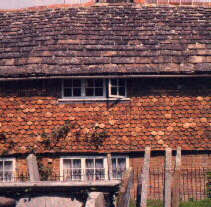THE CITY AND COUNTY PURCHASER AND
BUILDER'S DICTIONARY
Richard
Neve 1726 (facsimile reprint David & Charles)
p240 Slating
1 What] Slating is the
Covering of Houses with slate. This kind of Covering is very neat, especially
the Blue-slat; as for the other kind of Slate (known in some Places by
the Name of Horsham-stone) See Horsham-stone. The Blue-slate cut into long
Squares, or Escallops, shews very handsome, and is commonly us'd in Covering
of Summer, and Banquetting-houses in Gardens; it being a very light and
lasting Covering. But as this kind of Covering is very handsome, so also
'tis very chargeable; for Roofs cover'd with Slate, must be (first) boarded
over, the Slates hanged on Tacks, and laid with finer Mortar than Tiles.
But if these Slates be rudely cut, and carefully laid (with respect of
Form) it is then accounted a cheaper Covering than with plain Tiles; especially
in those Countries where the Earth affords plenty of them.
2 Price of] This kind
of Covering is valued by some from 3s to 6s the Yard square, or by the
Square of 10 Foot, (that is 100 Feet) from 30s to 3 pounds, or more in
some places.
3 Price of Pointing of Slates]
The Pointing of Slates (that is hewing them, and making them fit for the
Work,) is worth (says Mr Wing) about 12, or 13d per Square.
4 Prices of Slates] Slates
at the Pits (says Mr Wing,) 12 or 14s per Thousand which will nearly do
36 square Yards.
5 Of Measuring] Slating
in some places is measur'd by the Rod of 18 Foot Square which contains
324 superficial feet, or 36 square Yards. In measuring this sort of Work,
where there are Gutters or Valleys, there is commonly an allowance, which
is to take the length of the Roof all along the Ridge; which makes the
Gutters double Measure, viz. as much more as really it is; which in some
places is allow'd, and in others not; which depends upon the Custom of
the Place.
p164 Horsham-stone
1 What] Is a kind of
thin broad Slate of a greyish Colour much used in some parts of Sussex
formerly, not only to heal or cover Churches and Chancels but some great
Houses also; it is call'd Horsham-stone in that County, because it is for
the most part brought from a Town there called Horsham; this sort of Stone,
or Slate rather, is laid of different Sizes, viz. From 8 or 9 Inches. to
24 Inches, or more in length, or breadth etc. It is commonly from
1/2 Inch, to 1 Inch thick.
2 Of the Price of Horsham-stone.]
The value of them is according to the distance from the Quarry, viz. From
10 to 20s. per Load, I have known a Load of them laid in for 17 or 18s.
at 13 or 20 Miles distance from the Quarry. A Load of these, (as
I have been inform'd by those that have made some Observations on this
Matter,) will cover about ¾ of a Square.
3. Of Laying.] The Price
of laying a Square and Pointing (which is striking Mortar under the lower
ends) in new Work, 5 or 6s. But to rip it from old, and new lay and
point it, not less than 6 or 7s
per Square, which is the lowest I ever knew it done for.
4. Of the Weight of this sort
of Healing.] I have been informed by an observing Mechanick,
that a Square of this kind of covering will weigh about 33 or 34 C. weight
whereas, saith he, a Square of Tiling doth not weigh above 16 or 17 C.
weight. Nay, he is confident not above. 18 C. weight if it be gaged
at 6 Inches, and the Tiles not exceeding 10 Inches long. (Nay, I know that
in many Places they fall short of that.)
5. Of the Properties of this sort
of Covering.] From what hath been said before, you may easily
gather that this fort of Healing is dearer than Tiles; for the Charge of
a Square of Tiling, is from about 23s. to 30s. or some will have it from
24 to 28s. per Square; where I find by Calculations from some Observations,
a Square of Healing with Horsham-stone, will be worth from 32s to 38s.
And besides for this sort of Covering. the Timber for the Roof, ought to
be considerably stouter and stronger, because a Square of this sort of
stone is almost as heavy again as a Square of Tyling. Now that which
I suppose to be the cause why these Stones have been so much in use for
Churches, etc. must be, because they are far more durable than Tiles; which
makes some Recompence for the Charge; for some say these Stones are very
durable, being for the most part very hard, so that no Weather will
do them any hurt, as it will Tiles.
Notes on this text. Blue slat means
metamorphic slate. Healing means roofing |
